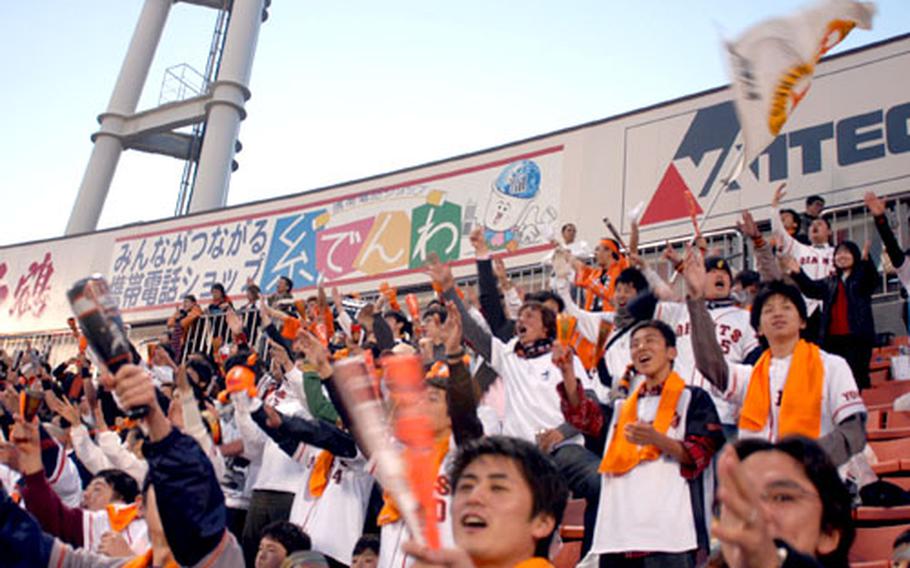
Fans of the Yomiuri Giants baseball team wearing the team colors of orange and black cheer their team at a Giants vs. Yokohama BayStars game in Yokohama on April 5. On-base groups run tours to Japanese baseball games. (Jim O'Donnell / S&S)
The Nippon Professional Baseball League began its 2005 season in March, offering a unique chance to experience a reflection of America with a Japanese translation.
Replete with announcers inciting the hometown fans, bugle calls, hot dogs (although on a stick), ice-cold beer and popcorn, the Japanese ballpark phenomenon is something every servicemember should experience, says Wayne Graczyk, author of the “2005 Japan Pro Baseball Fan Handbook and Media Guide.”
Graczyk says the Japanese game, called yakyu, isn’t better or worse than its American sibling — just different.
“For me, it’s the foreign players playing on the Japanese teams that really make Japanese baseball interesting,” said Graczyk, who has been a baseball columnist for the Japan Times for 28 years. “Plus the fact you have Japanese players going to the major leagues now, so we are seeing future major leaguers among Japanese players in Japan now.”
Graczyk says other differences between American Major League Baseball and Nippon Professional Baseball include size of the ball and stadium design.
“There is a minimum and a maximum size of the ball, and generally the major-league ball seems to be a little bit bigger than the Japanese ball,” Graczyk said. So when the major-league all-star teams come over at the end of the season to play a series against the Japanese, and they use the major-league-sized ball, the Japanese pitchers have a little bit of a tough time gripping it, he said.
Japanese baseball stadiums tend to be standardized, unlike in the United States, he said.
“There [are] no ballparks like Fenway Park or Yankee Stadium, where you have the ‘Green Monster’ in left field or it’s a shorter distance to the fence or one fence is higher or lower,” he said. “In Japan, all the ballparks are symmetrical and the fences are the same height.
“Whatever the distance is to right field, which is usually 100 meters (about 328 feet) … it’s the same to left field. And center field is a pretty standard 122 meters, which is 400 feet. So it’s about the same.”
Getting tickets for most games is as simple as walking up to the ticket counter, Graczyk said — with the exception of tickets to see the Yomiuri Giants, who play at Tokyo Dome.
“The Giants, they are the number one team in Japan, always have been, probably always will be. Some people call them Japan’s (New York) Yankees,” he said. “Their tickets are usually hardest to get, because when they go on sale there is usually a line to get them.”
He said the NPB teams tend to have very loyal and vocal fans, perhaps none more so than fans of the Chiba Lotte Marines, who play in Chiba, east of Tokyo.
“They have a tremendous cheering section. They fill their section of their bleachers and they all wear the black jersey of their team,” Graczyk said.
NPB cheering sections usually are in the outfield bleacher seats with the home-team fans often situated in the right field and the visiting-team fans in the left field. They tend to be the noisiest and most exciting areas in the stadium, according to Graczyk.
“They have a rule that one of their commissioners put into effect about 20 or 25 years ago saying that the fans and fan clubs … with the drums and the trumpets and the tambourines, have to be in the bleachers,” Graczyk said.
“You basically have two kinds of fans — you have the young kids in the cheering sections and you’ve got the businessmen in jackets and ties whose companies have season boxes and they go to the game after work … and they don’t like to be bothered by the loud noises of the cheering sections,” he said. “So they complained, and the commissioner said the cheering sections have to be on the bleachers.”
Graczyk said one of the best games at which to enjoy this fan interaction is when the Giants travel to Osaka to play the Hanshin Tigers.
“They are the rivals like the Yankees and the (Boston) Red Sox, or the Los Angeles Dodgers and the San Francisco Giants,” he said. “The Giants and the Tigers are archrivals. Especially when they play at Koshien, which is like (Chicago’s) Wrigley Field — it’s got ivy on the walls, although outside, not inside.”
Koshien stadium is like a shrine of Japanese baseball, Graczyk said.
“To really get the unique experience of a true Japanese baseball game to the max, you would go to a hot summer night in July or August at Koshien and see the Giants and Tigers play. It’s a really good experience.”